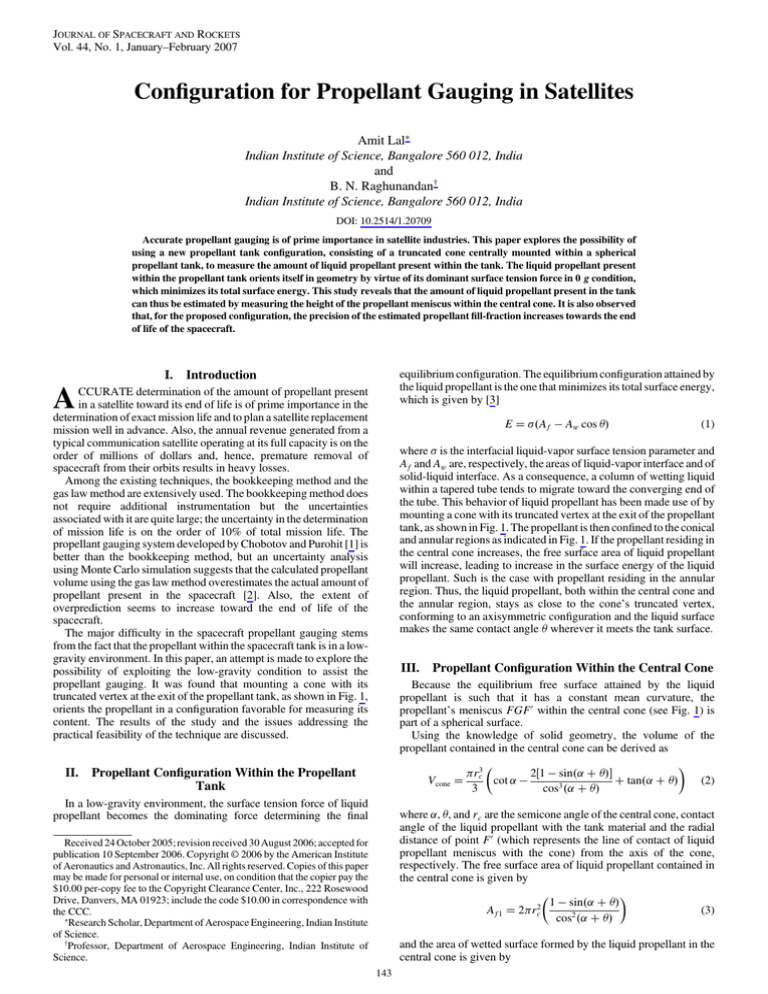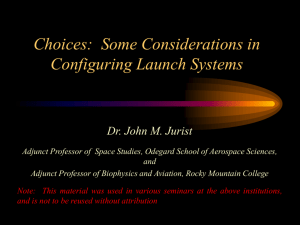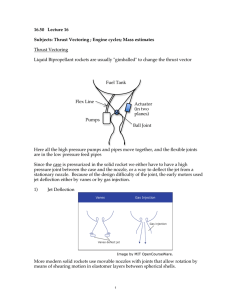
JOURNAL OF SPACECRAFT AND ROCKETS
Vol. 44, No. 1, January–February 2007
Configuration for Propellant Gauging in Satellites
Amit Lal∗
Indian Institute of Science, Bangalore 560 012, India
and
B. N. Raghunandan†
Indian Institute of Science, Bangalore 560 012, India
DOI: 10.2514/1.20709
Accurate propellant gauging is of prime importance in satellite industries. This paper explores the possibility of
using a new propellant tank configuration, consisting of a truncated cone centrally mounted within a spherical
propellant tank, to measure the amount of liquid propellant present within the tank. The liquid propellant present
within the propellant tank orients itself in geometry by virtue of its dominant surface tension force in 0 g condition,
which minimizes its total surface energy. This study reveals that the amount of liquid propellant present in the tank
can thus be estimated by measuring the height of the propellant meniscus within the central cone. It is also observed
that, for the proposed configuration, the precision of the estimated propellant fill-fraction increases towards the end
of life of the spacecraft.
equilibrium configuration. The equilibrium configuration attained by
the liquid propellant is the one that minimizes its total surface energy,
which is given by [3]
I. Introduction
A
CCURATE determination of the amount of propellant present
in a satellite toward its end of life is of prime importance in the
determination of exact mission life and to plan a satellite replacement
mission well in advance. Also, the annual revenue generated from a
typical communication satellite operating at its full capacity is on the
order of millions of dollars and, hence, premature removal of
spacecraft from their orbits results in heavy losses.
Among the existing techniques, the bookkeeping method and the
gas law method are extensively used. The bookkeeping method does
not require additional instrumentation but the uncertainties
associated with it are quite large; the uncertainty in the determination
of mission life is on the order of 10% of total mission life. The
propellant gauging system developed by Chobotov and Purohit [1] is
better than the bookkeeping method, but an uncertainty analysis
using Monte Carlo simulation suggests that the calculated propellant
volume using the gas law method overestimates the actual amount of
propellant present in the spacecraft [2]. Also, the extent of
overprediction seems to increase toward the end of life of the
spacecraft.
The major difficulty in the spacecraft propellant gauging stems
from the fact that the propellant within the spacecraft tank is in a lowgravity environment. In this paper, an attempt is made to explore the
possibility of exploiting the low-gravity condition to assist the
propellant gauging. It was found that mounting a cone with its
truncated vertex at the exit of the propellant tank, as shown in Fig. 1,
orients the propellant in a configuration favorable for measuring its
content. The results of the study and the issues addressing the
practical feasibility of the technique are discussed.
E Af Aw cos (1)
where is the interfacial liquid-vapor surface tension parameter and
Af and Aw are, respectively, the areas of liquid-vapor interface and of
solid-liquid interface. As a consequence, a column of wetting liquid
within a tapered tube tends to migrate toward the converging end of
the tube. This behavior of liquid propellant has been made use of by
mounting a cone with its truncated vertex at the exit of the propellant
tank, as shown in Fig. 1. The propellant is then confined to the conical
and annular regions as indicated in Fig. 1. If the propellant residing in
the central cone increases, the free surface area of liquid propellant
will increase, leading to increase in the surface energy of the liquid
propellant. Such is the case with propellant residing in the annular
region. Thus, the liquid propellant, both within the central cone and
the annular region, stays as close to the cone’s truncated vertex,
conforming to an axisymmetric configuration and the liquid surface
makes the same contact angle wherever it meets the tank surface.
III.
Propellant Configuration Within the Central Cone
Because the equilibrium free surface attained by the liquid
propellant is such that it has a constant mean curvature, the
propellant’s meniscus FGF0 within the central cone (see Fig. 1) is
part of a spherical surface.
Using the knowledge of solid geometry, the volume of the
propellant contained in the central cone can be derived as
r3
21 sin tan
(2)
Vcone c cot cos3 3
II. Propellant Configuration Within the Propellant
Tank
In a low-gravity environment, the surface tension force of liquid
propellant becomes the dominating force determining the final
where , , and rc are the semicone angle of the central cone, contact
angle of the liquid propellant with the tank material and the radial
distance of point F0 (which represents the line of contact of liquid
propellant meniscus with the cone) from the axis of the cone,
respectively. The free surface area of liquid propellant contained in
the central cone is given by
2 1 sin (3)
Af1 2rc
cos2 Received 24 October 2005; revision received 30 August 2006; accepted for
publication 10 September 2006. Copyright © 2006 by the American Institute
of Aeronautics and Astronautics, Inc. All rights reserved. Copies of this paper
may be made for personal or internal use, on condition that the copier pay the
$10.00 per-copy fee to the Copyright Clearance Center, Inc., 222 Rosewood
Drive, Danvers, MA 01923; include the code $10.00 in correspondence with
the CCC.
∗
Research Scholar, Department of Aerospace Engineering, Indian Institute
of Science.
†
Professor, Department of Aerospace Engineering, Indian Institute of
Science.
and the area of wetted surface formed by the liquid propellant in the
central cone is given by
143






